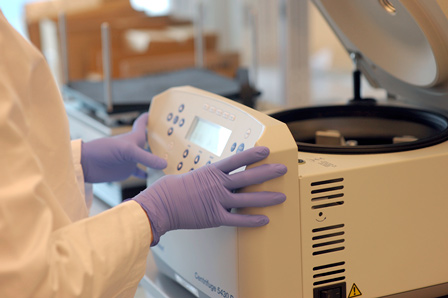
New York Genome Center employee using a centrifuge. Photo courtesy of the New York Genome Center. Photo by Charlie Samuels. Not to be reprinted without permission from the New York Genome Center.
Editors’ Note: Tomorrow an exciting new era in genomics formally begins in New York City. Einstein joins 11 other preeminent research partners as institutional founding members of the New York Genome Center as it formally begins operations. The facility is a unique collaboration that will create significant potential for sequencing immense amounts of data to advance biomedical research and human health.
by John M. Greally, M.B., B.Ch., Ph.D.
On lower Sixth Avenue, just above the Canal Street approach to the Holland Tunnel, the first seven floors of a 25-story postmodern building now house the New York Genome Center (NYGC). Familiarly known as 101AOA, the address at 101 Avenue of the Americas represents the physical focus of a collaborative genomics enterprise involving the major medical and research centers of New York. Inside 101AOA are a multitude of high-capacity DNA sequencers, computationally expert researchers who analyze huge amounts of data and trained lab personnel who run the machines.
But what’s truly remarkable is how the NYGC is structured. The center creates a meeting point at which highly accomplished researchers in the founding institutions and affiliates can join forces to solve complex genomics problems in New York City. The problems the center hopes to address are as diverse as biology itself.
At this point in history, genomics is not a niche discipline but is instead a fundamental technique applied pervasively in the life sciences. We can use genomics not only to search for disease mutations in a patient’s DNA; we can also identify the microbes in a person’s gut by sequencing the DNA in his or her feces. At the American Museum of Natural History, bones from extinct species are being dusted off so we can extract DNA to sequence their genomes, allowing us to understand something of what we have lost on our planet. Genomics techniques are the drivers of discovery in more fields of research than even the most optimistic scientist could have hoped a decade ago.
Having a genome center to serve so many New York City research enterprises places valuable resources at the disposal of its founding members. According to the NYGC, in 2012 these 12 members, including Einstein, accounted for extramural grant funding of about $1.35 billion awarded by the National Institutes of Health—that’s one in 18 extramural NIH dollars. With the NYGC as a genomics core, the sense of immense possibilities is tangible.
The NYGC will dramatically bulk up the DNA sequencing resources and data analytical capabilities for New York City. What is especially exciting is the experiment we are performing in building a community drawn from these multiple high-caliber research institutions.
In the still-young field of genomics, the sharing of data, ideas and insights achieves so much more than is possible for a single research institution working in isolation. All of the elements are now in place. September 19 will see an idea for a citywide genomics resource become a reality that should deliver real value to researchers and patient care.
Editors’ Note: The 12 institutional founding members of the NYGC are Albert Einstein College of Medicine of Yeshiva University, Cold Spring Harbor Laboratory, Columbia University, Cornell University/Weill Cornell Medical College, the Jackson Laboratory, Memorial Sloan-Kettering Cancer Center, Mount Sinai Medical Center, New York–Presbyterian Hospital, New York University/NYU School of Medicine, North Shore–LIJ Health System, the Rockefeller University and Stony Brook University.

